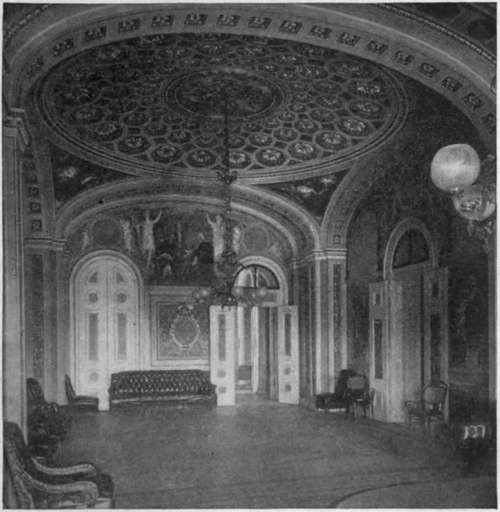Public Reception Room
Description
This section is from the book "The National Capitol. Its Architecture Art And History", by George C. Hazelton, Jr. Also available from Amazon: The National Capitol Its Architecture Art and History.
Public Reception Room
The public reception room before the eastern entrance to the Senate lobby owes much of its beauty to exquisite mural decorations in fresco by Brumidi, though the artist, because of other assignments of work, was never permitted to finish all the panels. On the northern portion of the ceiling are four groups representing Peace, Freedom, War and Agriculture. To the south, the center piece also is beautifully frescoed. In the four corners of the room are depicted the cardinal virtues, Prudence, Justice, Temperance and Fortitude. On the south wall is another interesting group, George Washington in consultation with two members of his Cabinet, Alexander Hamilton, first Secretary of the Treasury, and Thomas Jefferson, first Secretary of State. Northeast of the reception room, in the corner of the wing, is the room of the Sergeant-at-Arms of the Senate. On the wall hangs a full-length portrait (1875) °* Joseph Henry by Henry LTke, a Washington artist. Here also are traces of Brumidi's brush. To the east, a maiden, sadly breaking a bundle of fasces, indicates the dissolution of the Union. To the south is War. To the west, a maiden is cheerfully binding the bundle of fasces, each rod again in its place. To the north is Prosperity. The group in the center of the ceiling personifies the loving welcome of the erring daughter back into the fold.

PUBLIC RF.CF.PTION ROOM.
The hallway which forms the eastern approach to the Senate Chamber is rightfully much admired. It contains sixteen fluted columns of Italian marble, supporting a ceiling of the same costly material. The capitals of these columns might be styled Americanized-Corinthian, as the classic acanthus is gracefully surmounted by the native corn and tobacco leaves. It is said that while the columns were being carved, Jefferson Davis, Secretary of War, suggested the innovation as more representative of American products. The side walls, which are of plaster decorated in imitation of Sienna marble, are enriched by pilasters similar to the columns in material and design. They contain niches, which, no doubt, at some future time, will be filled with busts of the ex-Vice-Presidents whose memories are not already commemorated in other niches in the walls of the Senate wing.
Continue to:
